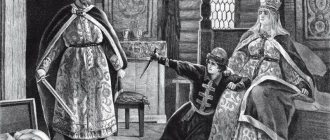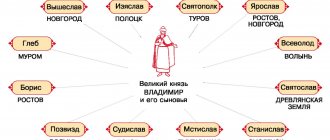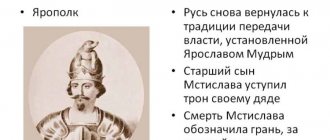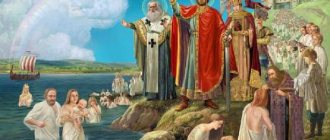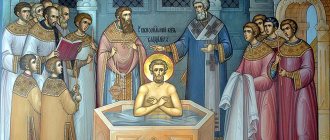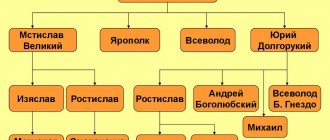Campaigns of Prince Vladimir I
Military campaigns of Prince Vladimir
Prince Vladimir was the illegitimate son of the Kiev Grand Duke Svyatoslav Igorevich, as well as Malusha, a native of the city of Lyubech, who was the housekeeper. Although the boy was born out of wedlock, according to pagan concepts, he acted as the legitimate son of his father and could, accordingly, lay claim to the Kiev throne.
Modern historians do not know exactly in what year Vladimir was born. Chronicles say that his father Svyatoslav Igorevich was born in 942, and the eldest son of Prince Vladimir himself was born around 977. Thus, we can conclude that the prince was born around 960.
After the angry Princess Olga sent the boy’s mother to Pskov, information about her is cut short, but young Vladimir began to be raised by his grandmother (Olga) and his maternal uncle, Dobrynya, who at that time was a member of the senior princely squad. Researchers of the prince’s life agree that it was his uncle who instilled in his nephew the desire to learn military affairs, which would be useful to him in the future on military campaigns.
The first military campaign of Prince Vladimir. 981
The first of them took place in 981 (although there is an unofficial version that tells us about an earlier date - 979). This year, the prince opposes the Polish prince Mieszko the First for the border territories called Cherven Rus, where, after several battles, Cherven and Przemysl were taken.
Military campaign against the Vyatichi
In addition, from 981 to 982, the prince made military campaigns against the Vyatichi, on whom Kievan Rus was eventually able to impose tribute. And in 983, the Kyiv prince managed to conquer the Balto-Lithuanian tribe of the Yatvingians, as well as establish Slavic control over Sudovia, which in itself was a considerable merit, because thanks to this the Russian state gained access to the Baltic.
Military campaign against Radimichi
A year later, in 983, Prince Vladimir launched a military campaign against the Radimichi, whose territories were located between the Novgorod lands and the “mother of Russian cities” Kiev. Thanks to the resulting control of the Radimichi, Vladimir was able to unite the southern and northern regions of Kievan Rus.
Hike to Volga Bulgaria
Less than a year had passed since Prince Vladimir went to war against the “Bulgars”. Some modern historians claim that these were the Danube Bulgars, but, according to the content of one of the chronicles, namely “Memory and Praise,” the so-called “silver”, that is, the Volga Bulgars, acted as opponents of the princely army. In the same year (985) Vladimir imposed tribute on Khazaria.
Also, according to some chronicle sources, in 988 the prince managed to conquer the territories of the Taman Peninsula and installed his son Mstislav, nicknamed the Brave, as prince there (Tmutarakan).
Siege of Korsun
In 988 and 989, the ruler of Rus' carried out the siege of Korsun in Crimea. After a long siege of the city, its inhabitants decided to surrender to the Russian army. This was largely due to the strategy of the prince, who ordered the soldiers to dig up the pipes through which fresh water from the wells flowed into Korsun. After this, the emperors of Byzantium sent their sister Anna to marry Prince Vladimir, which became the reason for the return of the conquered city under the protection of Byzantium. In addition, the ruler of Rus' did not want to quarrel with Byzantium on the eve of the baptism of the state, which he began to carry out with the help of Byzantine priests immediately after returning to his homeland in Kyiv.
In 991, Vladimir gathered an army and went to war in the Dniester lands against the White Croats, and a year later a fairly successful military event began against Poland for Cherven Rus. From 994 to 997, the Kiev Grand Duke Vladimir again launched a military campaign against the Volga-Kama Bulgars.
As you can see, Prince Vladimir became famous not only for his religious reform and competent domestic, but also for his very successful foreign policy. During his reign, he concluded many treaties with kings, kings and emperors of the most powerful powers. Among them were: Basil II (Emperor of Byzantium), Sylvester II (Pope), Boleslav I the Brave (King of Poland), as well as Stephen I (King of Hungary) and Boleslav II (King of the Czech Republic).
However, the biggest problem of Kievan Rus in that historical period, which Vladimir could not get rid of, remained the nomadic tribes of the Pechenegs, who regularly raided border settlements. All that a wise ruler could do against them was to set up a number of fortresses for defense, as well as a palisade along most of the state’s borders.
The fact that Prince Vladimir’s campaigns did not help against the Pecheneg raids can be learned from the records of the German missionary Bruno of Querfurt, who, on his way to them to preach the Gospel, stopped to stay with Vladimir. The Kiev prince warned him to abandon his idea, claiming that there was not a single soul there that could be saved.
Chronology of military campaigns of Prince Vladimir
| Chronology of military campaigns of Prince Vladimir |
Table: events of the reign of Prince Vladimir I
|
Wars of the 16th century
- Russo-Lithuanian War, 1500-1503
- Russo-Lithuanian War, 1507-1508
- Russo-Lithuanian War 1512-1522
- Eastern policy of Ivan the Terrible
- Livonian War, 1558-1583
- Ermak's campaigns in Siberia
- Russo-Swedish War, 1590-1593
Wars of the 17th century
- Polish-Swedish intervention, 1609-1618
- Swedish intervention. 1610-1617.
- Smolensk War, 1632-1634
- Russian-Polish War, 1654-1667
- Russo-Swedish War, 1656-1661
- Russo-Turkish War, 1676-1681
- Crimean campaigns of V. Golitsyn, 1687, 1689
- Azov campaigns of Peter 1, 1695, 1696
- Treaty of Nerchinsk with China, 1689
[edit] Links
- PVL
- VLADIMIR I SVYATOSLAVOVICH SAINT on the website “All the commanders of the world”.
- History of Russian Goverment. Vladimir's campaigns StarMedia
| [+] Reign of Vladimir Svyatoslavich (970-1015) | |
| Events | Baptism of Rus' • Baptism of Novgorod • Pagan reform |
| Wars | Military campaigns : Fight against the Pechenegs • Russian-Byzantine War |
| Family | Parents: Svyatoslav Igorevich, Malusha Wives (more details): Rogneda Rogvolodovna • Anna Byzantine Sons: Vysheslav • Svyatopolk • Izyaslav • Yaroslav • Boris • Gleb • Svyatoslav • Vsevolod • Mstislav • Pozvizd • Stanislav • Sudislav Daughters: Predslava • Premislava • Mstislava • Maria Dobronega |
EVENTS DURING THE REIGN OF VLADIMIR I SVYATOSLAVICH
During the reign of Prince Vladimir I Svyatoslavich, who received the name of the Saint in history, the lands of the Eastern Slavs united as part of the Principality of Kyiv. The territories on both sides of the Carpathians and the Cherven cities in Volyn were also annexed to Rus'. Vladimir chose Byzantine-style Christianity as the state religion of Kievan Rus.
Prince Vladimir was guided by the idea of subordinating the tribes and tribal unions of the Dnieper and Volga regions to Kyiv, in the future with the intention of establishing himself on the coast of the Baltic and Black Seas. He was the first to think of ensuring the protection of Russian borders from the invasion of hordes of Pechenegs and built a line of defensive fortifications along the Desna, Osetra, Trubezh, Sula and Stugna rivers. Fortresses were erected on the border with the steppe, which served as important patrol points for the advance of nomadic detachments and for organizing resistance against them.
The creation of a powerful state required Vladimir Svyatoslavich to strengthen the grand-ducal power and reform the ideology, the dominant form of which at that time was religion. At the beginning of his reign, he introduced a pagan pantheon, which included six gods, designed to unite the beliefs of people in equal parts of the Russian land. However, his attempt to turn paganism into the state religion was unsuccessful.
Later, Vladimir I Svyatoslavich carried out a religious reform, as a result of which Kievan Rus adopted Christianity according to the “Byzantine model.” The spread of Orthodoxy in lands remote from the capital often met with fierce resistance from the population, who continued to venerate pagan idols, not wanting to part with the traditions of their ancestors. Centuries passed before Christianity spread across vast areas of the country.
The Baptism of Rus' had a huge, progressive impact on the life of the country, strengthening state power and the territorial unity of the state of Vladimir. The establishment of Christianity as the dominant faith opened up broad prospects for Kievan Rus' economic and cultural development, introducing it to the achievements of Byzantine and European civilizations.
Reasons for accepting Christianity
reasons for the baptism of Russia , according to historians, were:
- The rising role of the state and the prince, the spread of inequality. The pagan gods were equal in power. Naturally, some of them stood out and required special worship, but in the general pantheon (group) they were on the same conditions. The whole life of the pagans passed with an eye on them. The will of the gods explained victories, defeats, famine and drought. Just like the gods themselves, all members of the pagan tribe considered themselves equal to each other. The supreme power of the prince and the state did not fit into this worldview, contradicting communal pagan ideas. Paganism could not explain why one person has the right to rule over others. There were many explanations for this in the Christian religion, and this was of decisive importance for the baptism of Rus' by Prince Vladimir.
- Centralization of the state. A single state had to correspond to one religion. The Baptism of Rus' made it possible to find such a religion. The centralization of the state was a significant reason for the adoption of Christianity by Vladimir.
- International situation. By the time of the adoption of Christianity in Rus', there were practically no pagan countries left in the world surrounding the Russian state. Paganism was perceived by neighbors as something outdated and even dangerous. European sovereigns did not want to trade and enter into dynastic alliances with the pagans. The baptism of Rus' led to a change in its status in the world. The political reasons for the adoption of Christianity in Rus' cannot be ignored. They did not want to marry pagans, and merchants were reluctant to do business with Russian merchants.
- Traditional, economic, political and cultural ties with Byzantium. According to legend, Vladimir did not know which religion to choose and sent ambassadors to different parts of the world with a demand to learn about each religion in detail and report to him. The returning ambassadors told about everything they saw, but most of all Vladimir liked Islam and Christianity. He only swayed in favor of the latter when he learned that Muslims were forbidden to drink wine. This was the main reason for the adoption of Christianity by the Russian land. According to another version, the reason for the adoption of Christianity in Rus' was Vladimir’s desire to erect the same majestic temples as were in Byzantium.
Grand Duke Vladimir chooses faith
Guided by these, and possibly personal reasons for the adoption of Christianity in Russia (an early marriage to Princess Anna, a former Christian), Vladimir accepted Christianity in 988 and baptized Russia. This is how a single religion appears, fully consistent with the concept of a sovereign, unified state.
Greek clergy come to baptize Russia with Vladimir According to the plan of the Byzantine emperor, the newly created Russian Orthodox Church was to be subordinate to the Patriarchate of Constantinople. But Vladimir immediately stopped all attempts to control this sphere of life of the Russian state, achieving recognition of the independence of the Russian patriarchy. The legend about the baptism of Rus' tells that before the adoption of Christianity, Vladimir had at least 600 wives and concubines. After the baptism of Kievan Rus, they all become free. Christianity, unlike the Muslim religion, did not approve of polygamy.
Vladimir's baptism
Approval of Vladimir to reign in Kyiv
After his marriage, Vladimir sent his squad south. In the area of Lyubech, the Varangians and Novgorodians met with the army of Yaropolk and defeated it. Grand Duke Yaropolk left Kyiv and took refuge in the small town of Rodnya. Chroniclers claim that Yaropolk was surrounded by a traitor named Blud. He betrayed the prince to his brother and he was killed by Varangian warriors. In the Tale of Bygone Years, the date of Yaropolk’s death is considered to be 980, but historians have differing opinions on this matter. In earlier chronicles there is a mention that the prince was killed in the summer of 978.
Vladimir Svyatoslavovich, whose reign later became known for the most significant events in the history of Ancient Russia, was a wise and far-sighted man. In order to earn the love of the people, and at the same time get rid of witnesses to the murder of his brother, immediately after receiving the Kiev throne, he expelled most of the Varangian people from the city warriors who helped him in the fight against his brother. Instead, warriors of Slavic origin were recruited into the squad. Under Vladimir, there were already two entire squads - the senior (consisted of advisers, governors, governors - “husbands”) and the junior (included young warriors, youths). Vladimir's reign was recognized by his contemporaries as fair. The years of Vladimir's reign were 980 -1015.
[edit] Reasons
Prince Vladimir's entire life was spent in constant military campaigns not only against neighboring peoples, but also against Russian princes who did not want to recognize him as their eldest prince. The discord between Prince Vladimir and his brothers began after the death of Prince Svyatoslav. His eldest son Yaropolk, who wanted to expand his Kiev inheritance, attacked his brother Oleg, killed him and, having captured the Drevlyansky land, moved to Novgorod, forcing Prince Vladimir, who was sitting there, to flee across the Baltic Sea. Two years later, having recruited a squad from the Varangians, Vladimir, in turn, attacked the governors of Yaropolk in Novgorod, then captured Polotsk and Kiev and killed Yaropolk.
Having become the Grand Duke and uniting all Russian lands under his rule, Prince Vladimir undertook a series of campaigns against his northern and western neighbors. While his governor Wolf Tail was pacifying the Radimichi and Vyatichi, Prince Vladimir and the Varangians conquered the Lithuanian tribe of the Yatvingians, who lived in the territory of what is now the Grodno region of Belarus, and took the land of the Cherven cities from Poland.
Prince Vladimir's uncle, Dobrynya Nikitich, with great success made a campaign to the east, against the Volga Bulgarians who inhabited the Kama River basin.
Simultaneously with these campaigns, Prince Vladimir had to take active measures against the Pechenegs and other Turkic nomadic tribes, who carried out devastating raids on the southern borders of Kievan Rus. To protect them, Prince Vladimir built fortifications, the remnant of which is currently the so-called Serpentine Ramparts.
Baptism of Ancient Rus'
In his desire to strengthen the prince’s personal power and statehood, Vladimir thinks about the need for everyone to accept a single faith. Initially, he hoped that the Slavs would abandon the rest of the pagan gods and would worship only Perun, whose idol he erected in Kyiv. But on the ground, ordinary pagans did not understand why they could not ask for protection from other gods, considering Perun not as the supreme god, but as one of many. This spiritually and politically divided the pagan tribes and created grounds for conflict. Vladimir had a completely different goal. This is how the idea of the need to baptize Kievan Rus appeared, which was also the reason for the religious reform carried out earlier.
The struggle for reign after the death of Svyatoslav
There was no law on succession to the throne in Ancient Rus'. This meant that all the sons of Svyatoslav had the right to become Grand Dukes (chief above all) and reign in Kyiv. Initially, the reign in Kyiv went to Yaropolk, but in 977 Oleg and Yaropolk quarreled and went to war against each other. The struggle for the great reign began between the brothers .
The official reason for the quarrel and the outbreak of internecine war was the murder of the son of the governor Sveneld by the people of Prince Oleg. Sveneld asked Yaropolk for protection. The Prince of Kiev gathered a squad and headed to his brother’s lands. During the battle with the Kievans, Oleg was thrown into a ditch, where he died. In the Tale of Bygone Years there is a mention that Yaropolk was very worried about the death of his brother.
Having learned about the death of Oleg Drevlyansky, Vladimir fled to the Varangians. Instead, Yaropolk's protege was sent to Novgorod. Vladimir hid among the Varangians for 3 years. This time was enough for him to convene a large army, with which he appeared under the walls of Novgorod in 980 and re-established his princely power there. But Novgorod alone was not enough for Vladimir. He planned to take the Kiev throne, and for this he needed allies. There were no people who wanted to become such, so the prince decided to get married and thus strengthen his position. Vladimir wooed the daughter of the Varangian prince Rogvolod, who reigned in Polotsk. But the girl refused him, deciding to marry Yaropolk. To prevent such a union, Vladimir attacked Polotsk, killed all the relatives of the would-be bride and married her against her will.
Vladimir Red Sun

